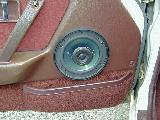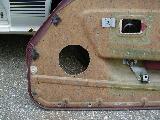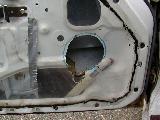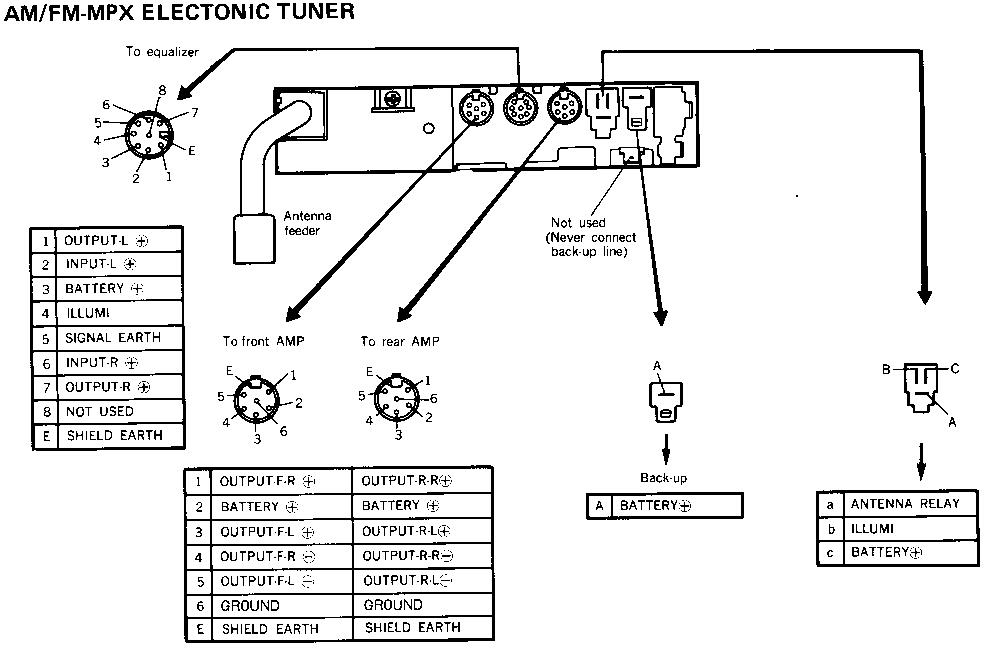The GSL-SE Stereo System
Mazda's 3-component electronic-tuner/tape/equalizer system, made by Clarion
This page last updated 8/11/01.
I came up with a great sounding stereo for my RX-7 without spending megabucks.
No audiophile with half a brain and at least one good ear would deny that
upgrading to top quality speakers is the absolute most important thing
that one can do to improve the sound of any system.
The stock electronics of this system feed into two 25 watt per channel
stereo amplifiers located under the storage compartments behind the seats.
Mazda doesn't give any distortion specs for these amps, but if they can
put out 10 "clean" watts per channel (and maybe 25 watts, peak)
then that should be more than enough for most person's listening habits.
With reasonably efficient speakers, that should be enough for a clean 100
decibels on average -- maybe about lawnmower volume. There's a few tricks
that can be done to clean up the sound a little more.
If you have any questions that I haven't already covered here, feel
free to e-mail
me.
Speakers:
The stock speakers are "full-range," single-driver Panasonics -- 4" inches
in the front, mounted in the kick panels, 6 1/2" in the rear, mounted aft
of the strut towers. The first thing I did was replace these with Infinity
Reference Series two-way speakers of the same sizes in the stock locations.
(There are plenty of other good brands. Polk Audio and Boston Acoustics
come to mind.) The new speakers were a perfect fit, requiring no cutting
or drilling, and they resulted in an immediate improvement in mid- and
high-frequency response.
I prefer to have the sound-stage in front of me. But the 6 1/2" rears
were just overpowering the 4" fronts. I could use the console-mounted fader
to compensate, but the 4" speakers couldn't put out enough bass. The equalizer
could help add bass, but the system just didn't seem to "come alive" until
I turned the volume knob way up. (And it still wasn't very loud. 4" full
range speakers will always be very inefficient.) I blew two
sets of those little 4" Infinities before I gave up on trying to get reasonable
volume and bass out of them. The kick panel location of the original system
didn't help much, either. All of the mid and high frequencies were firing
into my ankles. It was time to move to door mounted speakers.
After taking the interior door panels off, I found a location that could
accept 6 1/2" speakers without interfering with the power window mechanism.
6 1/2" speakers at all four corners should result in good imaging and frequency
response, even into the mid-bass range. I decided to get a little better
speaker for the doors, so I moved up to Infinity's Kappa Series of two-way
speakers.
Mounting the Front Speakers:
I'll save you the trouble of determining how and where to make your speakers
fit in these doors: measure 3.75" up from the top edge of the map
pocket, and 7.75" back from the front edge of the door panel. That's where
the center of my speakers are on the door. Drill a pin hole through the
door panel at that point.
 Then take the door panel off, and use the mounting template that (probably)
came with your speakers to cut a circular hole in the door panel. Tip:
Cut an undersized hole, and check and double check clearances frequently
throughout the process. You can always cut away more material to make the
hole bigger, but it's really difficult to put material back if the hole's
too large.
Then take the door panel off, and use the mounting template that (probably)
came with your speakers to cut a circular hole in the door panel. Tip:
Cut an undersized hole, and check and double check clearances frequently
throughout the process. You can always cut away more material to make the
hole bigger, but it's really difficult to put material back if the hole's
too large.
 When you're done cutting, mount the door panel back on the door, mark
off the sheet metal on the door, and cut away the little bit of metal that
you'll probably need to remove. (Use sheet metal sheers, not a hack saw
like I did during my first such speaker installation. The saw will create
metal shavings that will get stuck in the bottom of the door and clog up
the drainage holes, eventually causing the bottoms of the doors to rust.)
Note that speakers all have different sized magnets, and that will be the
biggest factor in determining how much metal you'll need to remove, and
where. (Or, for that matter, whether or not you can even use this
location without coming into contact with the window regulator as the window
raises and lowers. This location proved to work well with both the Infinity
Kappa 6.5" speakers that I used in my old '84 GSL-SE, as well as the Boston
Acoustics RX-series speakers that are in my '85.)
When you're done cutting, mount the door panel back on the door, mark
off the sheet metal on the door, and cut away the little bit of metal that
you'll probably need to remove. (Use sheet metal sheers, not a hack saw
like I did during my first such speaker installation. The saw will create
metal shavings that will get stuck in the bottom of the door and clog up
the drainage holes, eventually causing the bottoms of the doors to rust.)
Note that speakers all have different sized magnets, and that will be the
biggest factor in determining how much metal you'll need to remove, and
where. (Or, for that matter, whether or not you can even use this
location without coming into contact with the window regulator as the window
raises and lowers. This location proved to work well with both the Infinity
Kappa 6.5" speakers that I used in my old '84 GSL-SE, as well as the Boston
Acoustics RX-series speakers that are in my '85.)
 If you've never installed speakers before, you can see that it's obviously
not a highly technical job -- it's more of an art, and you'll get better
at it with experience. It requires a little cutting of the door panels
and sheet metal, but if you're smart about it and don't rush into things,
even a novice can do it. The rule is "measure everything, then double-check,
triple-check and then measure yet again." Or hire someone!
If you've never installed speakers before, you can see that it's obviously
not a highly technical job -- it's more of an art, and you'll get better
at it with experience. It requires a little cutting of the door panels
and sheet metal, but if you're smart about it and don't rush into things,
even a novice can do it. The rule is "measure everything, then double-check,
triple-check and then measure yet again." Or hire someone!
Standard Disclaimer: If you screw up your own speaker installation,
too bad. I didn't measure your speakers, or the clearances where you intended
to mount them, or do your cutting for you, or anything else. It's your
car, and if you can't do this job right and you refuse to hire a professional
who can, then you're the one who has to live with it. End of sermon.
Once the front speakers were mounted, the result was outstanding --
clean, bright sound at any volume; much more efficient, giving some relief
to the stock amplifiers; and excellent stereo imaging, with the sound stage
right in front of you where you want it.
My only remaining complaint: the Infinity Reference Speakers in the
rear are very slightly more efficient than the Kappas up front, so I still
have to compensate slightly with the fader. The Kappas sound a little
cleaner throughout their range, though. In retrospect, I should have gone
with Kappas all around. It's easy to fix, though -- replace the rear speakers.
(I've since sold the car that this page was written about, and I've installed
four identical Boston Acoustics RX-67 speakers in my newer '85 GSL-SE.
The Bostons have somewhat smoother response than the Infinity speakers
in the old car, and using four identical speakers at all four corners took
care of the front-to-rear balance problem.)
The above speaker replacements will probably be as much as most music-lovers
would ever wish for. But I wanted more....
Adding a Subwoofer:
A subwoofer is a speaker designed to handle very low bass, such as the
notes from a bass guitar or some orchestral instruments, or even the low
notes of a pipe organ. There are many types available. (Try Crutchfield
for an overview.) I ended up getting a Kenwood powered tube-style subwoofer.
It fit's nicely in the RX-7 hatchback, and it comes with a 60 watt amplifier
and a continuously variable crossover. I hooked it up to the rear amp
hookup coming out of the electronic tuner. (See shop manual diagram, below.)
Pins 1, 3, 4 and 5 should be obvious enough -- they're for the audio signal.
Pin 2 is an accessory power lead, to turn the subwoofer amplifier on and
off with the rest of the system. The sub also requires a full-time power
lead, which I took from the stock amplifiers under the storage bins. (Any
full-time source will do. Most folks run a line from the fuse-box -- I
just found the mid-car location of the amps to be more convenient.)
 What all this does for me is that it allows me to continue to use the
OEM joystick fader in the RX-7's center console, and the fader on the tuner
can be used to fade out the subwoofer, if you ever want to demonstrate
why you have that "thing" in the back of your car.
What all this does for me is that it allows me to continue to use the
OEM joystick fader in the RX-7's center console, and the fader on the tuner
can be used to fade out the subwoofer, if you ever want to demonstrate
why you have that "thing" in the back of your car.
I was able to purchase the 6-pin DIN connector from a local electronics
store. (To my recollection, Radio Shack had either the 6-pin male
connectors or the 8-pin connectors, but not both. One of these days I'll
check, and then I'll update this page.)
The same wiring could have just as easily fed a separate subwoofer amp
-- they make amplifiers with built-in low-pass crossovers, just for use
with a subwoofer -- and subwoofer drivers mounted where the storage compartments
once were. But that's a future project.
Crossovers and Filters:
I added line-level high-pass filters to the signal lines coming out of
the tuner, and before the joystick fader in the console. (Again, pins 1,
3, 4 and 5.) This has the dual benefit of limiting the amount of deep bass
that would go to the main speakers (I don't feel like buying any more speakers)
and also saving some of the main amplifier power for the mid- and high-frequencies.
This makes it much less likely that I'll overdrive the main amps
into clipping, so that it's equally unlikely that I'll fry any more tweeters.
The whole system can get louder, while still having very clean sound.
Crutchfield sells a very inexpensive line of filters called F-Mods by
Harrison. For all of $30, these connect via male & female phono-plugs,
require no power supply wiring (unlike a component-type crossover) and
fit very easily in the console behind the stereo. There are various frequencies
available, but I chose 100hz high-pass filters as a mid-bass cutoff that
I could match nicely with the continuously variable low-pass cutoff frequency
of the subwoofer.
The Results:
After purchasing a test CD ($12) and a sound level meter ($30 at Radio
Shack), I was able to adjust the subwoofer crossover frequency to produce
a frequency response that is flat (+/- 1 db!) from 42hz to about 200hz.
I was unable to get reliable measurements above that frequency due to standing
waves within the car interior but, trust me, it sounds very clear and uncolored.
At the maximum volume at which the system still sounds clear to me, I measured
peak volumes of over 120db at normal listening positions!
With the rock, jazz and blues that I usually listen to, the system has
plenty of punch and sounds almost as clear as my home system. It's equally
capable with any classical music, including Bach organ fugues that would
tax any aftermarket system. Cathedral sound in a two seater -- this is
cool. :)
The point of all this is that you don't need to trash the original stereo
that fits so well in the console. The electronics have reasonable frequency
response, comparable to many contemporary tuner/amps. The original amps
put out a healthy 100 watts total, plus the 60 or so supplied by the aftermarket
subwoofer. With the exception of the door mounted speakers, the interior
retains it's original appearance. Best of all, there's enough clean sound
available to make for a great tailgate party!
 Then take the door panel off, and use the mounting template that (probably)
came with your speakers to cut a circular hole in the door panel. Tip:
Cut an undersized hole, and check and double check clearances frequently
throughout the process. You can always cut away more material to make the
hole bigger, but it's really difficult to put material back if the hole's
too large.
Then take the door panel off, and use the mounting template that (probably)
came with your speakers to cut a circular hole in the door panel. Tip:
Cut an undersized hole, and check and double check clearances frequently
throughout the process. You can always cut away more material to make the
hole bigger, but it's really difficult to put material back if the hole's
too large. When you're done cutting, mount the door panel back on the door, mark
off the sheet metal on the door, and cut away the little bit of metal that
you'll probably need to remove. (Use sheet metal sheers, not a hack saw
like I did during my first such speaker installation. The saw will create
metal shavings that will get stuck in the bottom of the door and clog up
the drainage holes, eventually causing the bottoms of the doors to rust.)
Note that speakers all have different sized magnets, and that will be the
biggest factor in determining how much metal you'll need to remove, and
where. (Or, for that matter, whether or not you can even use this
location without coming into contact with the window regulator as the window
raises and lowers. This location proved to work well with both the Infinity
Kappa 6.5" speakers that I used in my old '84 GSL-SE, as well as the Boston
Acoustics RX-series speakers that are in my '85.)
When you're done cutting, mount the door panel back on the door, mark
off the sheet metal on the door, and cut away the little bit of metal that
you'll probably need to remove. (Use sheet metal sheers, not a hack saw
like I did during my first such speaker installation. The saw will create
metal shavings that will get stuck in the bottom of the door and clog up
the drainage holes, eventually causing the bottoms of the doors to rust.)
Note that speakers all have different sized magnets, and that will be the
biggest factor in determining how much metal you'll need to remove, and
where. (Or, for that matter, whether or not you can even use this
location without coming into contact with the window regulator as the window
raises and lowers. This location proved to work well with both the Infinity
Kappa 6.5" speakers that I used in my old '84 GSL-SE, as well as the Boston
Acoustics RX-series speakers that are in my '85.) If you've never installed speakers before, you can see that it's obviously
not a highly technical job -- it's more of an art, and you'll get better
at it with experience. It requires a little cutting of the door panels
and sheet metal, but if you're smart about it and don't rush into things,
even a novice can do it. The rule is "measure everything, then double-check,
triple-check and then measure yet again." Or hire someone!
If you've never installed speakers before, you can see that it's obviously
not a highly technical job -- it's more of an art, and you'll get better
at it with experience. It requires a little cutting of the door panels
and sheet metal, but if you're smart about it and don't rush into things,
even a novice can do it. The rule is "measure everything, then double-check,
triple-check and then measure yet again." Or hire someone! What all this does for me is that it allows me to continue to use the
OEM joystick fader in the RX-7's center console, and the fader on the tuner
can be used to fade out the subwoofer, if you ever want to demonstrate
why you have that "thing" in the back of your car.
What all this does for me is that it allows me to continue to use the
OEM joystick fader in the RX-7's center console, and the fader on the tuner
can be used to fade out the subwoofer, if you ever want to demonstrate
why you have that "thing" in the back of your car.